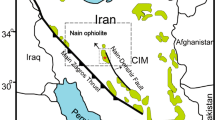Abstract.
We report highly unusual platinum-group mineral (PGM) assemblages from geologically distinct chromitites (banded and podiform) of the Kraubath massif, the largest dismembered mantle relict in the Eastern Alps. The banded chromitite has a pronounced enrichment of Pt and Pd relative to the more refractory platinum-group elements (PGEs) of the IPGE group (Os, Ir, Ru), similar to crustal sections of ophiolites. On the contrary, the podiform chromitite displays a negatively sloping chondrite-normalised PGE pattern typical of ophiolitic podiform chromitite. The chemical composition of chromite varies from Cr# 73–77 in the banded type to 81–86 in the podiform chromitite. Thirteen different PGMs and one gold-rich mineral are first observed in the banded chromitite. The dominant PGM is sperrylite (53% of all PGMs), which occurs in polyphase assemblages with an unnamed Pt-base metal (BM) alloy and Pd-rich minerals such as stibiopalladinite, mayakite, mertieite II, unnamed Pd–Rh–As and Pd(Pt)–(As,Sb) minerals. This banded type also contains PGE sulphides (about 7%) represented by a wide compositional range of the laurite–erlichmanite series and irarsite (8%). Os–Ir alloy, geversite, an unnamed Pt–Pd–Bi–Cu phase and tetrauricupride are present in minor amounts. By contrast, the podiform chromitite, which yielded 21 different PGMs, is dominated by laurite (43% of all PGMs) which occurs in complex polyphase assemblages with PGE alloys (Ir–Os, Os–Ir, Pt–Fe), PGE sulphides (kashinite, bowieite, cuproiridsite, cuprorhodsite, unnamed (Fe,Cu)(Ir,Rh)2S4, braggite, unnamed BM–Ir and BM–Rh sulphides) and Pd telluride (keithconnite). A variety of PGE sulpharsenides (33%) including irarsite, hollingworthite, platarsite, ruarsite and a number of intermediate species have been identified, whereas sperrylite and stibiopalladinite are subordinate (2%). The occurrence of such a wide variety of PGMs from only two, 2.5-kg chromitite samples is highly unusual for an ophiolitic environment. Our novel sample treatment allowed to identify primary PGM assemblages containing all six PGEs in both laurite-dominated podiform chromitite as well as in uncommon sperrylite-dominated banded chromitite. We suggest that the geologically, geochemically and mineralogically distinct banded chromitite from Kraubath characterises the transition zone of an ophiolite, closely above the mantle section hosting podiform chromitite, rather than being representative of the crustal cumulate pile.
Similar content being viewed by others
Author information
Authors and Affiliations
Additional information
Electronic Publication
Rights and permissions
About this article
Cite this article
Malitch, K.N., Thalhammer, O.A., Knauf, V.V. et al. Diversity of platinum-group mineral assemblages in banded and podiform chromitite from the Kraubath ultramafic massif, Austria: evidence for an ophiolitic transition zone?. Miner Deposita 38, 282–297 (2003). https://doi.org/10.1007/s00126-002-0308-1
Received:
Accepted:
Issue Date:
DOI: https://doi.org/10.1007/s00126-002-0308-1




